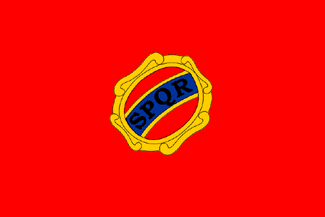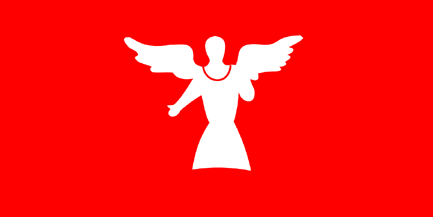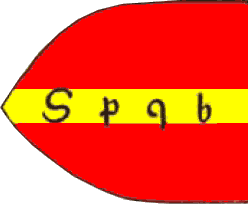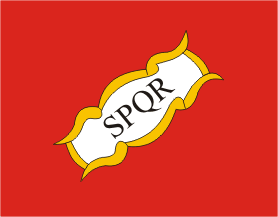
image by Jaume Ollé , 31 October 1998

Last modified: 2021-08-24 by rob raeside
Keywords: italy | rome | roma | roman republic | spqr |
Links: FOTW homepage |
search |
disclaimer and copyright |
write us |
mirrors
See also:
Other Sites:

image by Jaume Ollé , 31 October 1998
This flag seems to be traditionally used in the region (middle
age?). The flag of the anciant republic was red with SPQR in it.
Later, in the Christian era the cross was added.
Jaume Ollé , 31 October 1998
SPQR is the acronym of 'Senatus PopulusQue Romae', i.e. 'the
Senate and People of Roma'. This was a kind of 'motto' of the
Ancient Roman Republic, which was applied on state monuments in
Roma. SPQR seems to have been used also in the Roman vexilla, at
least in the vexillum shown on the first page of Asterix albums
(and in the first image of the first album of the series, Asterix
le Gaulois).
Ivan Sache, 18 March 2001
I'd like to make a remark about the traditional flags of the
city of Rome: the colours shouldn't be brilliant red and yellow,
but - in a more correct way - dark red (bordeaux like) and gold.
The first one is the symbol of the emperor, and gold for
sovereignty.
Giovanni Pellegrini, 10 April 2001
This is perhaps quibbling, but SPQR actually stands for
"Senatus Populusque Romanus", "The Senate and
People of Rome" (literally the Roman Senate and
People). The expression is clearly written out in a number
of inscriptions, so there is no guesswork involved. I
suppose one could say that it was a kind of "motto",
but I think that it is more accurate to say that this was the
official monogram of the Roman Republic. From what I have
been able to gather, official documents of the Senate were placed
under a seal that read "SPQR". The SPQR
represented the Roman Republic in the same way that
"US" or "USA" represents the United States,
or the way that "UN" (or "NU", if you speak
French) is used as an identifying mark on the helmets and
vehicles of United Nations peacekeepers. Roman armies
carried standards with the SPQR monogram, and it was used in
official inscriptions and official documents.
The modern city of Rome has revived it for use, *inter alia*, on
manhold covers and curbside trash cans, to indicate two places
where I saw it used. Interestingly when I was in Benevento,
I saw "SPQB" on the manhold covers there -- which can
only stand for "Senatus Populusque Beneventanus", the
Senate and People of Benevento. Since there never was any
such thing, I could only guess that this was an attempt to poke
fun at the modern Romans' revival of the SPQR monogram. It
is said that modern Italians like to say that SPQR actually
stands for "Sono pazzi questi romani", "Those
Romans are crazy."
David J. White, 10 April 2002
I wouldn't be sure that the use of SPQB by Benevento is simply
intended as a parody of Rome. SPQ* has been widely used all
over Europe and beyond, from Liverpool and London to Olomouc in
the Czech Republic and Vienna (Senatus Populusque Viennensis), to
Florianopolis, Santa Catarina, Brazil (SPQ Florianopolitanus) as
an assertion of municipal pride and civic rights. I
remember very well seeing SPQF (SPQ Florentinus) in Florence, but
the fact that many municipalities using the initials were never
independent city-states seems to be no obstacle.
Joe McMillan, 10 April 2002
SPQR has been used on several modern reconstructions of Roman
flags and vexilloids, see for instance the eagle (aquila)
standard on the page of the re-enactment group "Legio
XXIV" (<www.legionxxiv.org>).
However, as far as it is known, the SPQR, though used widely in
inscriptions, was never used on any kind of flags in antiquity.
The main reason would be: These flags were basically military
standards for the respective military units, and not *national*
flags. As the soldier all belonged to the Roman army, which was
in essence marked by the whole system of flags, they didn't need
a reminder. These flags (vexilla as well as signa of different
units) contained other inscriptions, though; in most cases these
would be short forms of the name of the unit, for instance
"LEG II AUG" for "Legio II Augusta", a legion
stationed in Britain. A vexillum with this inscription can be
seen on the "Bridgeness distance slab" from the time of
emperor Antoninus Pius (138-161 AD). See also Roman Empire - Historical Flags.
M. Schmoger, 14 April 2002
It is my understanding that the bases of the eagle standards
for the legion itself (after the reforms of Marius which did away
with other legion symbols) had the letters "SPQR" on
them, like the regimental number for Napoleon's regiments did. I
had not heard of the letters being on vexilla of the legion -
just the eagle standard itself.
Greg Biggs, 16 April 2002

image by Jaume Ollé , 31 October 1998
Is this flag supposed to represent the City of Rome sometime
during the era of pontifical rule; the city and surrounding
district during that time; or the entire Papal States?
Ned Smith, 15 June 2006
See also: Vatican - Historical Flags

image by Ivan Sache, 18 March 2001
A vertical tricolour black-white-red.
Alessandro Martinelli , 29 Januaty 1996
Roma republic was created 7 March 1798. The flag, took from
the french flag, was granted by Napoleon. It was in use until the
supress of the republic on 29 September 1799. The flag was
Vertical black, white, red.
Jaume Ollé , 31 October 1998
Znamierowski [zna00] shows (p.
118) the flag used by the Roman Republic between 1798 and 1799.
We have the flag described as a vertical tricolor
black-white-red.
Ivan Sache, 18 March 2001
Roberto Breschi, in his presantation: "Flags in
Italy under Napoleon's pressure" at ICV 20 in Stockholm,
gave February 1798 as the date of adoption.
Dov Gutterman, 4 August 2003

image by Jaume Ollé , 31 October 1998
Roma Ensign from XIX century plates.
Jaume Ollé, 31 October 1998

image by Jaume Ollé , 31 October 1998
In 1849 a Roman Republic was proclaimed.
Jaume Ollé, 31 October 1998

image from Wikipedia
Photo of different flag
at <www.tricolore.it>.
Dov Gutterman, 23 July 2002
Same different flag appears at Wikipedia.
Ron Lahav, 2 February 2008

image by António Martins-Tuválkin, 15 November 2007
The 29th flag mentioned and illustrated in the Book of All
Kingdoms [e9s50] is attributed to
Rome. This as depicted in the 2005 spanish illustrated
transcription [e9s05], a red flag
with a thin yellow horizontal stripe and black letters reading
"Spqb" (sic!) on it but slightly overflowing;
flag shown in the ogival default shape of this source.
The anonymous author of [e9s50]
describes the flag thusly: "Las seńales de Roma son un
pendón bermejo con una vanda de oro en que son letras
d’esta manera (The sign of Rome is a red pendon with a
golden bar on which are letters like this).
Neither this exact design (Gules are bar Or) nor the unexpected
spelling "Spqb" are known, though this flag shares many
features with all above versions and variations - letters on red
and gold.
António Martins-Tuválkin, 15 November 2007
National Geographic 1917 describes the lettering as standing
for Senatus Populusque Romanus which they translate as "the
Roman Senate and People." The National Geographic
illustration (p. 370, no. 1048) differs from this illustration
and the Hakluyt Society edition (plate 6, no. 24) in that it
shows the lettering "Spqp" and not "Spqb".
Phil Nelson, 17 November 2007
"Spqp" would be accepatble if the last letter is
taken as glyphic alternative for "r", which is not far
fetched for the 14th century.
António Martins-Tuválkin, 18 November 2007

image by Jaume Ollé, 14 November 2003
Addition No. 128 - Rome.
Source: [stb62]
Jaume Ollé, 14 November 2003